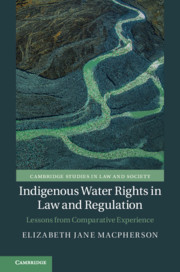Book contents
- Indigenous Water Rights in Law and Regulation
- Cambridge Studies in Law and Society
- Indigenous Water Rights in Law and Regulation
- Copyright page
- Dedication
- Contents
- Acknowledgements
- Chapter One Introduction
- Part I Conceptualising Indigenous Water Rights
- Part II Comparative Country Studies
- Chapter Four The Limited Recognition of Indigenous Water Rights in Australia
- Chapter Five Water Rights for Māori in Aotearoa New Zealand
- Chapter Six Rivers as Subjects and Indigenous Water Rights in Colombia
- Chapter Seven Recognising and Allocating Indigenous Water Rights in Chile
- Part III Lessons Learnt
- Glossary
- Bibliography
- Index
- Cambridge Studies in Law and Society
Chapter Four - The Limited Recognition of Indigenous Water Rights in Australia
from Part II - Comparative Country Studies
Published online by Cambridge University Press: 20 July 2019
- Indigenous Water Rights in Law and Regulation
- Cambridge Studies in Law and Society
- Indigenous Water Rights in Law and Regulation
- Copyright page
- Dedication
- Contents
- Acknowledgements
- Chapter One Introduction
- Part I Conceptualising Indigenous Water Rights
- Part II Comparative Country Studies
- Chapter Four The Limited Recognition of Indigenous Water Rights in Australia
- Chapter Five Water Rights for Māori in Aotearoa New Zealand
- Chapter Six Rivers as Subjects and Indigenous Water Rights in Colombia
- Chapter Seven Recognising and Allocating Indigenous Water Rights in Chile
- Part III Lessons Learnt
- Glossary
- Bibliography
- Index
- Cambridge Studies in Law and Society
Summary
In Chapter 4 I consider the limited recognition of traditional, cultural water rights in Australian law. In the Australian model, property rights in water and water markets accompany government oversight and planning. Australian water law has undergone drastic reforms since the early 1990s, yet little has been done to provide indigenous peoples with the right to use water on their lands for commercial and productive purposes. Native title rights to water have been interpreted narrowly by the courts according to traditional and cultural uses, and are usually accounted for as in-stream cultural and conservation values in water catchments, distinguishing them from the consumptive rights held by other users. Yet indigenous Australians continue to make up the most disadvantaged sector of Australian society and Australian governments have committed to reducing that disadvantage, including by supporting the productive use of indigenous lands. The Australian experience demonstrates the difficulties inherent in recognising historical indigenous rights to land and resources, as indigenous water practices change over time and conflict with other uses. The study highlights the need for an allocative model, enabling both the reservation of water for indigenous allocation and the redistribution of water rights in fully allocated catchments.
Keywords
- Type
- Chapter
- Information
- Indigenous Water Rights in Law and RegulationLessons from Comparative Experience, pp. 49 - 98Publisher: Cambridge University PressPrint publication year: 2019
- 1
- Cited by

